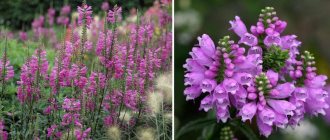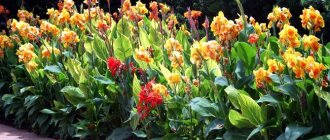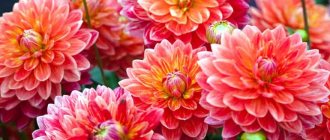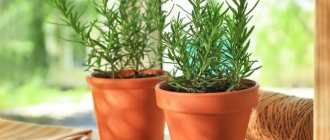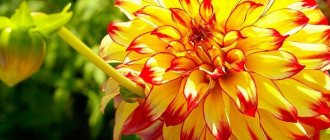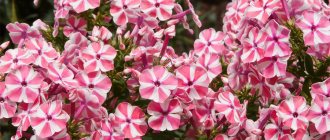Caring for dahlias is an important issue for many gardeners. That is why this issue will be discussed in the article.
One of the most beautiful, bright and long-blooming flowers. Here is a brief description of perennial garden plants - dahlias. This flower has 42 species and belongs to the Asteraceae family or, as they are also called, Asteraceae. Its main advantage is that it blooms from May - July until frost. But you need to be able to plant them correctly and care for them, which is what information will be provided in this article.
What a perennial dahlia looks like: photo
In common or colloquial conversation, the name of a flower is attributed to the masculine gender, but in the professional sphere it is associated, on the contrary, with the feminine class. That is, the ending “a” is added.
Interesting facts from history:
- The flower has two roots of origin. More precisely, its naming. The Latin version of "dalia" comes from the surname of the Swedish botanist Anders Dahl. But the Russian variation was obtained in honor of the geographer Johann Georgi from St. Petersburg.
- This type of flower was first discovered in Mexico back in the 15th century. Then the plant was used as food and helped against many diseases. Its most common use is in the treatment of epilepsy.
Biological description:
- Root system. In dahlias it is represented by root tubers or root cones. While the stem dies every year, the root tubers can live for several years. Therefore, the plant was given the status of a perennial flower. They have a thickened and fleshy structure. They do not have eyes that will give rise to shoots. That's why the next part is so important.
- Root collar . This is the transition from tubers to plant stems. In this place, the outer part dies off and the rudiments of future shoots appear. Therefore, this is the most important part of the plant.
Important! When digging in autumn, you need to be extremely careful with this part; it must not be cut off or damaged. Otherwise, the plant will simply die completely.
- Stem. They are straight and branched, and can be smooth or rough (depending on the species). The thickness ranges from 3 to 6 cm, and it is hollow inside. Therefore, heavy inflorescences and intense wind can easily break the plant. The height of the bush depends on the variety: Dwarf dahlias grow only 0.7-1 m in height
- Medium-sized ones can reach approximately 1.5 m
- But tall ones reach 2-2.5 m
Variety:
- Simple dahlias. Their flower stalks have one line of petals, up to 10 cm in diameter. The height of the plant reaches 45-60 cm.
Simple dahlias
- Anemoneaceae . They already have several layers of petals, in the middle of which their shape is slightly elongated and tubular. The diameter of the inflorescence is the same, but the height of the ground part can reach up to 90 cm.
Anemone species
- Chrysanthemum-shaped . The size of the plant is the same as that of anemone dahlias. The petals of the plant have a reed-like shape, twisted into a tube. Color can range from white to red, including yellow and pink tints. Reminds me of chrysanthemums.
- Collared. The size of the bush is slightly larger - 75-125 cm. The inflorescences really have the shape of a collar. The outermost flowers have one row of petals of the same color. But the core has a different color with short and twisted petals.
Collared dahlias
- Peony-shaped. The inflorescences are slightly larger - 12-15 cm, with straight and flat petals along the edges of the flower and with a tubular, inner core. The height of the plant itself is the same as the previous type.
- Decorative. The largest species, since the inflorescences can be from 8 to 23 cm, and the height reaches 60 cm.
- Globular. The name speaks for itself - the inflorescences resemble a ball in shape, but sometimes they can be slightly flattened with double and tubular petals. The dimensions of the flower are 8-15 cm, the ground part is 90-120 cm.
Globular dahlia
- Pompons. They have double inflorescences of a round shape, the diameter of which is above 5 cm. A distinctive feature is twisted marginal flowers with a blunt and rounded end. Bush height up to 120 cm.
Pompom look
- Cactus dahlias. The inflorescences also have a double shape, with a diameter of 8-25 cm. The height of the stem reaches 150 cm. The distinguishing feature is narrow and pointed, twisted marginal flowers.
cactus species
- Semi-cactus . The dimensions of the plant are the same as in the cactus version. But the marginal petals are slightly curled away from the middle of the core. Nymphaeaceae . Very similar to water lilies. The inflorescences are double and regular in shape. Their diameter ranges from 7 to 20 cm, the height of the bush can be up to 135 cm.
Important! There are even black dahlias. Or rather, red and black. The merit of this color is that the plant contains a large amount of pigment - anthocyanin. It is this that saturates the plant in red, blue or purple color. And a large percentage of it creates a black tint.
When to start preparing the roots of perennial dahlias for planting after winter: planting dates
Dahlias are heat-loving plants. They are terribly afraid of drafts. By the way, take this into account when choosing a landing site. They need to be taken out of a cellar or other storage place when the earth is already sufficiently saturated with heat.
Consider your latitude:
- in the southern regions, tubers need to be prepared from the end of April
- in a mixed natural zone this period falls in the month of May
- but in the northern area it’s the beginning of June
Important! The air temperature should not be lower than 18-20°C.
How to select the right dahlia tubers for planting?
There is nothing complicated or supernatural in this process. It is necessary to remove dried tubers and remove damaged areas by cutting. The main thing is to treat the places of “trauma”. Most often, ordinary brilliant green, a weak solution of potassium permanganate, or ash are used. The last material should be carefully rubbed over the required area.
Tuber processing
- It’s better to place all the tubers in a weak solution of potassium permanganate for 30 minutes to 1 hour.
- Experienced gardeners have noted another method - an ash solution. You need to pour ¼ bucket of ash with cold water and leave for a day. Top water and use to disinfect tubers. They need to be placed for 2-3 hours.
- Those tubers that do not contain growth buds also require special attention. They are attached to a common center with thin roots. After planting in flower beds they rot. Therefore, trim them without regret; it will not cause damage to the bush.
How to properly divide and process dahlia tubers for planting?
After small shoots have appeared, you need to start dividing the roots. Some gardeners carry out this operation in the fall. But practice shows that in this case, the damage to planting material increases several times due to rotting or drying out.
- The root, so-called “mother’s nest” must be divided into separate segments with a sharp knife. Each of them should have a root collar and 1-2 growth buds.
- There is no need to leave extra buds. Otherwise, the planting will give all its juices to the development of extra stems, and not to the creation of inflorescences. Then the flowers will turn out small and weak.
Important! If there are a lot of buds on one tuber, then it is better to cut the root in half. The main thing is to equally divide the root collar. In this case, you will get propagation of dahlias by cuttings.
- After which, the tubers are again placed in pots. Now you need to ensure regular watering. The temperature should be reduced to 15 °C. After they take root, dahlias can be planted in open ground.
- It is better to carry out the watering procedure using a spray bottle. Otherwise, the tubers may rot.
Care and cultivation
Dahlias do not tolerate prolonged drought or excess moisture. In rainy summers, flowers may die. In hot, dry weather, dahlias are watered once a week, even if there has been no rain in 7 days. Starting from the second half of August, watering and fertilizing of dahlias is completed.
It is advisable to remove buds that have already bloomed in time, this way you can prolong flowering.
Despite the powerful appearance of the stems, dalia are fragile and easily break from a gust of wind. A garter is definitely needed for medium-sized and tall varieties.
If the stem is broken, it can be saved by applying a splint. Attach the board to the fracture and tie it on both sides with rope. Even on such plants flowers appear.
Feeding
After planting, to speed up growth, dahlias are fertilized with ammonium nitrate or a solution of infused bird droppings. Potassium fertilizers are applied as soon as the first buds appear - this is necessary for abundant flowering.
Loosening and mulching
Recently planted and watered tuber roots are mulched - sprinkled with a mixture of sawdust and peat or chopped tree bark.
Loosening and mulching retains moisture for a long time. Such procedures are useful if you plan to leave the plantings for a long time during a hot period.
Bush formation and pinching
Before starting pinching, the owner of the flower garden must decide what is more important: the quality and size of an individual flower or their quantity. In tall dahlias, in any case, you need to cut off the lower shoots. They will not produce buds, but will only take away strength. To prevent faded buds from wasting nutrients, it is better to remove them.
It is normal to leave 3 strong stems on one bush of medium-sized and tall dahlias. Low-growing crops do not need pruning or pinching. They already form a lush bush with abundant flowering.
Stepchildren can be found at the base of dalia leaves. These are small shoots that the plant does not need. They need to be removed before the buds appear, this will cause less stress to the plant. Stepchildren should be cut as close to the stem as possible.
In large-flowered dahlia varieties, part of the buds is removed. This is necessary if large flowers are required for cutting. If you need to get one out of three buds on a stem, then the side ones are plucked out. If the choice falls on quantity, then the middle bud should be removed.
To strengthen the stem and to prevent diseases in tall dalias, all leaves are removed at a distance of 40 cm from the ground.
Reproduction
There are 4 main ways to propagate dahlias:
- Dividing tubers. Produced in the fall, before storing for the winter. Such propagation allows you to preserve all the characteristics of the variety.
- Graft. For the procedure you need a tuber unsuitable for planting and a dalia cutting.
- Seed method. In autumn, stems with wilted buds are cut off, and the seeds are ripened at home.
- Cuttings. The advantage of this method is that it increases disease resistance and quality of flowers.
Is it necessary and in what to soak the roots of perennial dahlias before planting?
Yes, dahlias need to be soaked 2 hours before planting. Most ordinary water will do. This procedure is necessary so that the soil is well saturated with moisture and the roots are easily removed from the container. If there are shoots higher than 10 cm, or additional sprouts appear, they need to be carefully broken off. Don't leave more than 3 stems.
Important! Before planting, try to gradually move the plant into fresh air. Start with 10 minutes, gradually increasing the time by 50 minutes. This should be done a few days before planting in open ground.
Choosing a suitable location
When choosing a place where dahlias will settle in the future, you need to take into account the purpose of their cultivation - decorative or propagation for sale. If you plan to sell dahlia tubers, then the planting scheme will differ from that when growing these flowers to decorate the site.
The recommendations below for planting dahlias and caring for them in open ground are relevant for central Russia and the CIS countries (Primorsky, Altai Territories, the southern part of the Khabarovsk Territory and Western Siberia, the Southern and Middle Urals, the Baltic states, Belarus, the northwestern part of Ukraine) . When growing in more southern regions and countries, it will be necessary to make adjustments to climate conditions, shifting planting and harvesting dates, as well as changing agricultural techniques.
When choosing a place to grow dahlias, you need to take into account their features, including:
- high need for water (the higher the air temperature, the more water is needed);
- short growing season;
- the need for support and garter due to the fragility of the stems.
It is important to create an optimal microclimate that will allow you to obtain the maximum decorative effect of dahlias in a relatively short period. The landing site should be protected from cold northern, northeastern and northwestern winds and drafts, and warm up well. In combination with low air temperatures (from 1 to -4 degrees), strong winds can cause dahlias to freeze, especially if they were recently planted from greenhouses and did not have time to receive the necessary hardening.
In the southern regions, the danger is posed by hot winds - northeast, east and southeast winds carrying heated dry air. They dry out the soil and the above-ground part of dahlias, causing burning of young foliage and the top of the plant.
To protect a flower bed with dahlias from the winds, the area is surrounded by trees, regular or fruit, and fences or protective strips are used. Often the site is given a slope - southern or south-eastern for the middle zone and northern or north-western for the southern regions.
Important! Lowlands, basins, and valley areas, where cold air usually accumulates and late spring frosts often occur, should be avoided.
In the shade of trees or fences, dahlias grow well and remain highly decorative if the sun illuminates them for at least half a day. However, you should avoid planting these flowers in the zone of action of the root system of large tall trees, since they will not be able to bloom normally and form viable root tubers.
When choosing a site for planting dahlias, great attention should be paid to the issue of groundwater occurrence. They should not rise above 60-70 cm from the ground surface. If the water rises higher in the area, you should artificially raise the flower bed with dahlias to protect their root system from rotting.
In hot southern regions, on the contrary, flower beds with dahlias are often arranged in a depression surrounded by earth banks. At night, this depression is filled with water to ensure sufficient moisture supply to the roots.
How do you treat the soil for perennial dahlias before planting?
Chernozem needs to start fertilizing in the fall. To do this, treat the area with humus. In the spring, the top layer needs to be mixed with compost and gold. To do this, start the rake.
- Please note that dahlia loves neutral or slightly acidic soil. Alkaline soil can be amended by adding some peat moss in the spring.
- Slaked lime will help reduce acidity.
Important! Maintain crop rotation! You cannot plant tubers in the same place for more than 3 years. Spores of fungi and diseases, as well as remains of rot, remain in the ground.
- Also, do not plant dahlias with asters. They are susceptible to the same diseases, so they can transmit them to each other.
Diseases
Dahlias suffer from diseases such as black leg, viral mosaic, bronzing and leaf spot, oak mosaic, gray and white rot, and bacterial cancer. The reason lies in viruses, bacteria and fungi. For these diseases, you can spray the plants with Topaz and Hom. Diseases can only be effectively combated by culling and burning affected plants . Disinfection of soil, garden tools, pest control and compliance with crop rotation also help a lot.
Scheme and depth of planting dahlias in a flowerbed: description
Proper planting is another important key to healthy growth and long flowering of dahlias.
- You need to dig holes that are three times the size of the tubers themselves. Also note that you need to add 7-10 cm for fertilizers and deepening the root system.
- The distance between the holes directly depends on the dahlia variety. For low-growing plants it should be 30-50 cm, but for tall or giant dahlias it should be 80-90 cm.
- If the soil is very dense, then place some drainage at the bottom of the hole. One shovel of gravel or crushed stone is enough.
- Humus, a little sand and fertilizer are also laid. All this is covered with earth and then watered well. You can also add bone and dolomite meal. A handful of ash will not be superfluous. The entire mixture should occupy half of the hole.
- The tubers are placed in the hole so that the eye is directed upward. The rhizomes are covered with 2-5 cm of soil.
Planting dahlias in a flower bed
- By the way, for large bushes, immediately take care of installing support.
- Seedlings need to be watered abundantly and only with warm, but not hot, water. When the shoots grow and the ground settles a little more, gradually add soil. Until the hole is filled to the top.
- Be sure to mulch the soil. To do this, use peat or tree bark.
- When the shoot appears, it needs to be watered as needed. Before this, watering is carried out a little more often.
Soil selection and preparation
Dahlias love loamy or well-fertilized sandy soil. In autumn, it is necessary to dig up the soil to a depth of 30 cm. At the same time, enrich the soil with 15-18 kg of rotted manure and 25 g of superphosphate per 1 square meter. Two or three weeks before planting, the distant area is dug up again, but only potash fertilizers (potassium sulfate or nitrophoska) are applied.
Slightly acidic or neutral soil is ideal for dahlias. To reduce acidity in the fall, add slaked lime in the amount of 300-800 g per 1 square meter. m.
If you need to increase the water permeability of heavy soil, then use peat or coarse sand.
Dahlias do not tolerate drought, so the planting site should not be adjacent to large trees that take away moisture and nutrients. The planting site should be near buildings or bushes to protect the plant from the wind. Lowlands and swampy areas are extremely undesirable.
What and how many times should I feed dahlias after planting?
You need to take care of fertilizing in the fall. Then you should add fertilizer to the soil before planting. When you plant the tubers directly, each hole is fertilized separately. After which the feeding of the plants themselves begins.
- The first feeding should be carried out no earlier than 7-10 days after planting. But the tubers must have time to take root. The safest and healthiest are mullein infusions. You need to dilute 1 kg of manure in 10 liters of water.
- You can also use superphosphate and ammonium nitrate. Requires 20 g of substances per 10 liters of water.
- Ash, which must first be kept in water for a day, has proven very good.
- During the spring, 3-4 feedings are carried out with an interval of 10-14 days.
- In summer, potassium and phosphate fertilizers are more needed. To do this, take 50 g of the substance and 3-4 handfuls of ash per 10 liters of water. No more than 4 such procedures should be carried out during a period.
- The last feeding is carried out after the end of flowering. For this, potassium sulfate is used at a rate of 30 g of the substance per bush.
Caring for dahlias
Dahlias are quite demanding regarding planting conditions and further care. To achieve a highly decorative flower bed, you will have to provide the plants with the most suitable conditions.
Watering, loosening, mulching the soil
After the seedlings have settled into their new location, watering is reduced, but the soil under the dahlias should always remain moist. With a lack of water, the stems quickly become woody, growth slows down and flowering deteriorates. It is quite difficult to restore the decorative appearance of dahlias after this - it returns slowly after the onset of cool, rainy weather.
To provide dahlias with optimal air humidity, moisturizing watering is carried out using sprinklers (with small holes). 10-15 minutes of such watering allow you to temporarily increase air humidity in hot weather.
It is very important to keep the soil under dahlias loose and regularly clear of weeds. It is usually loosened after each watering or fertilization. After buds appear on the dahlias and the green mass of the plants closes, loosening stops, and the soil is mulched with peat or humus. This is done to slow down the growth of weeds, prevent crusting of the soil and reduce the amount of watering, since mulch allows the soil to remain moist longer.
Recommendation: if the vegetative mass develops excessively, the lower leaves of the bushes are cut off to a height of 30-40 cm to improve air ventilation. This avoids the formation of a thick stem at the root collar, which impairs the preservation of tubers.
After the onset of stable cold weather, dahlias are earthed up. This will protect the roots from the first frosts, while the hilling height should be 15-20 cm. If the plants were planted deep, then hilling can be omitted.
Feeding
The need to apply mineral or organic fertilizers to dahlias depends on the type of soil in which they are planted. Fertile soils that are regularly fertilized with organic matter and humus need it less. You can determine which fertilizers dahlias need on a particular soil by submitting samples to an agricultural laboratory for chemical analysis. It allows you to plan the application of fertilizers for the next 2-3 years.
Fertilizers are applied in three ways:
- when plowing the soil before planting;
- when planting in each hole;
- foliar or root feeding.
If fertilizers are selected incorrectly, they may be ineffective or even harmful to plants. That is why it is recommended to regularly, once every 2-3 years, conduct a chemical analysis of the soil.
In the fall, when digging, as a rule, organic fertilizers are added - manure, composts, especially if they have not had time to decompose sufficiently. In spring, wood ash, superphosphate and aged peat are plowed into the ground.
It is not recommended to add easily soluble chemicals to the soil, as they are easily washed out of the soil and are not used by dahlias for their intended purpose. Among these substances:
- ammonium and other nitrates;
- potassium salt;
- urea (synthetic urea);
- potassium chloride.
The latter is recommended to be applied to heavy clay soils. Before planting, fertile lands are not additionally fertilized with dahlias, but fertilizing is applied only to the planting holes. To do this, use humus (leaf or manure) mixed with wood ash or stove soot. Add 3-4 tablespoons of ash to a bucket of compost, and add a quarter of a bucket of the mixture to each hole.
During the period of growth and flowering, dahlias are regularly fed with organo-mineral fertilizers - once every 12-14 days. To do this, use diluted cow manure or chicken droppings (for 10 liters of water, 1 liter of manure solution or 0.5 liter of chicken droppings solution) with the addition of potassium (15 g) or ammonium nitrate (10 g), superphosphate (15-20 g) and potassium sulfate (10-15 g). A bucket of feeding mixture (10 l) is divided between 4-5 plants.
Such fertilizing continues until mid-July, then they are replaced by phosphorus-potassium fertilizers. And after the second half of August, preference is given to phosphorus fertilizing. After each application of fertilizer, the bushes must be watered with a sprinkler.
Important! Lack of water, phosphorus and potassium can slow the transfer of nutrients from the stem and leaves to the roots in the fall.
Preparing for winter
Dahlias do not overwinter in open ground. In the fall, after the above-ground part dies off (usually after the first frost), the root tubers are dug up and placed in storage.
You need to dig up the tubers on the first day when the air temperature is above zero, because if there is a delay, the buds may wake up and cause the tuber to rot. Before digging, the stems are cut with garden pruners at a distance of 3-4 cm from the root collar, and then the nests are removed from the soil using a fork or shovel. The tubers are laid out in boxes and placed in a cool, damp room for several weeks (+8 degrees with a humidity of 80%).
After 2-3 weeks, the nests are cleared of small roots and old tubers, the cuts are processed, and placed in boxes for storage. The bottom of the boxes is covered with a 3 cm layer of earth, then the tubers are laid out and covered with earth. Store boxes at a temperature of 1-7 degrees Celsius and high air humidity (80-100%).
You can also store tubers by treating them with a clay mash. Cleaned root tubers are washed under running water, dried in the sun, dipped in a mash and dried again. The resulting “dragées” are sent for storage until spring.
How often to water perennial dahlias after planting in open ground?
Plants are watered once every 2 weeks. Especially, monitor the condition of the soil in the heat and during the period of bud formation. If there is a lack of moisture during the ovary of inflorescences, then the flowers will be small and ugly. Therefore, during this period, watering increases by 1.5-2 times. After flowering begins, watering is reduced and done as needed.
Try to carry out the watering procedure in the evening or early in the morning, when the dew has subsided. Also, do not pour water on the leaves of plants. On hot days this can cause burns. And excess moisture will lead to root rot.
Feeding and fertilizers
In order for the bush to bloom luxuriantly and not be attacked by pests, periodic feeding must be done during the growing season. Do the procedure at least 2 times a month. In order for the plant to receive all the necessary substances, you need to alternate the use of mineral and organic fertilizers.
Infusions of mullein, chicken droppings, and ammonium nitrate are used as organic fertilizers. The bush will grow to full size if you add superphosphates or potassium fertilizers when the first two buds appear. You also need to plant the sprouts in well-fertilized soil. It is important not to overdo it with fertilizers, so as not to destroy the flower.
Reproduction of dahlias: description
There are five ways to propagate dahlias. One, the most common one, was indicated above - this is division by tubers. Therefore, we will omit detailed information in order not to repeat ourselves.
- Division by tubers. It is worth adding just one more important information - this procedure should be carried out every year. This helps rejuvenate the plant and prevents the formation of small flowers.
- Cuttings. This was also mentioned a little above. This method increases the ability of dahlias to resist disease. And it should be noted that the growth of the flower increases significantly. After dividing the tuber in half, it is planted again in the ground. It is important to ensure that the root collar remains open. You need to water constantly to keep the soil moist.
- The temperature should be up to 25 °C. When shoots appear, reduce it to 15-17°C. At the same time, move the box with seedlings to a bright place. If the weather is cloudy, then you need to take care of additional lighting.
- When the sprouts grow to 10 cm, they are cut with a stationery knife. This should be done obliquely, leaving a couple of millimeters at the base. This will allow you to grow several shoots.
- After this, the cuttings are placed for three weeks in a moist substrate in separate containers. Make sure there is sufficient heat and light. During this period, they need to be adapted to the environment, gradually increasing the ventilation time.
- They need to be planted in pots or containers with good drainage (2-3 cm of gravel is enough) and nutritious soil. Cuttings should be planted 2-3 cm into the ground, at a distance of 5-7 cm from each other.
- At first, it is necessary to provide abundant watering. It is advisable to use a solution of manure, mullein or litter. After the first leaves appear, the cuttings can be planted in open ground or pots.
- To do this, cut off the inflorescences in the fall and leave them to dry in a dry and well-ventilated area.
Dahlia propagation
- Reproduction by grafting. This method allows you to create very large and beautiful plants, but, unfortunately, it is very painstaking. You need to take a healthy, but unsuitable for planting, tuber and the required cuttings.
- Wash the root vegetable, dry it and make a cylindrical hole in it. And the stalk itself needs to be sharpened at the bottom. Then insert the cutting into the opening of the tuber.
- The junction must be tightly wrapped with a cotton or woolen rope. After this, you can plant them in the soil.
- If you notice an unusual bud on a bush, cut it off and cut lateral inflorescences 10-12 cm long from it.
Choosing a dahlia variety
There are more than 9,000 varieties of dahlias. Beginner flower growers are better off starting with less capricious, low-growing varieties (for example, “cheerful guys”). They are sown with seeds in spring in open ground or planted as seedlings. These dahlias are not suitable for cutting, but they delight the eye with their flowering all summer and early autumn. After wilting, the seeds are collected from the inflorescences for the next year. For planting, it is better to choose areas protected from the north wind without shading.
In addition to the “cheerful guys”, similar dahlias include the following varieties:
- "Vasilisa";
- "Bright pom-poms";
- "Dandy";
- "Figaro".
"Bright pom-poms." The variety has a strong stem with semi-spreading branches. The name characterizes the shape and color of the dalia. The colors are really rich and bright: yellow, red, purple, orange, boiling white. The heads of the inflorescences reach 8 cm in diameter.
“Bright pom-poms” are good for forming bouquets, decorating flower beds and garden paths.
"Figaro". A small dense bush 20-35 cm high, which can accommodate up to 15 double inflorescences. Each basket reaches a diameter of 12 cm.
The variety looks appropriate in flower beds and flowerpots. Does not require special care, prefers any soil except wetlands.
"Dandy". The bush is up to 45 cm high, has original semi-double inflorescences. The petals are different in size and color, this makes the variety unique. Blooms until late autumn.
“Dandy” is universal and can join other flowers in borders and edgings.
"Vasilisa." A variety with small flowers 7 cm in diameter and a low bush 15 cm high. A godsend for balconies and flowerpots. The color of the inflorescences is varied from a bright palette (red, orange, yellow) to delicate shades (pink, pale lilac).
In order for the bush to be lush and bloom profusely, earlier pinching is necessary. The soil requirement is looseness and moderate fertility. "Vasilisa" tolerates partial shade well.
Tuberous varieties are more difficult to grow. Tall crops require staking. In the fall, the tubers are dug up and stored until spring in special conditions.
There are the following types of dalia grown from tubers:
- Medium height;
- short;
- Tall.
Recently, low-growing dahlias have been gaining popularity among gardeners. They look great on borders and in pots on loggias.
The Gallery variety series includes dahlias that form small neat bushes, no more than 40 cm high. They are resistant to diseases and pests. Strong stems can withstand any weather. The Gallery series includes the following varieties: “Rembrandt”, “Princess Grace”, “Princess Park”, “Happy Butterfly”.
Low growing varieties
"Rembrandt" is a small bush with neat but large inflorescences. The flower is pink at the edges, white closer to the center, and the core is yellow.
“Princess Grace” differs from the previous variety in its more lush inflorescence.
“Princess Park” is a border cactus-like variety of culture. The petals resemble needles and create a basket 10 cm in diameter. The color is usually pink or purple. In open ground, flowering is possible from July until the first frost.
When combined with castor beans and canna, they create an exotic style in the garden.
“Happy Butterfly” is a dahlia with an original single flower. The petals are colored with stripes of pink and purple. The center of the flower is bright yellow. On borders and flower beds, “Happy Butterfly” is combined with annual flowers (zinnia, lobelia, cosmos).
Medium-sized varieties
Medium-sized dahlia varieties have a stem from 70 to 120 cm.
This variety includes the following varieties:
Fringed dahlias include the ice crystal . The basket with a diameter of 15 cm is white on the edges and yellow in the center.
"Tartan" belongs to the large decorative family of dahlias. The stems are quite massive and strong, but during the flowering period they require a garter for support. One bush produces from 4 to 5 burgundy inflorescences. The edges of the petals are white, which makes the “taratan” an effective and eye-catching accent in the flowerbed.
"Boogie Woogie" is an anemoid dahlia with a strong stem. During the entire period of growth, it does not require garters. The color of the dense inflorescences is a mixture of pink and yellow. The aroma exudes a light, sweetish one. “Boogie Woogie” is suitable for making bouquets and can last in a vase for up to 7 days. With proper care and a sunny growing location, it blooms profusely and for a long time. In the flower garden it is combined with annual plants of contrasting colors.
Large-flowered dahlias include the variety "Spartacus" . It has one of the most beautiful inflorescences of rich red, crimson or burgundy color, sometimes with white stripes on the bent petals. The diameter of such a hat is 25 cm. In front gardens and flower beds, “Spartacus” looks very elegant and solemn. Suitable for cutting and making bouquets.
"Yellow Jill" is a variety related to spherical dahlias. The bushes reach a height of 100-120 cm. Flowering is abundant from late June to late autumn. The spherical inflorescences are yellow in color with a red core.
Tall varieties
Tall varieties of dalia are distinguished by stems with a height of 150 cm to 200 cm. Such flowers definitely need strong support and protection from strong winds.
There are the following varieties of this variety of dahlia:
- "Barbarossa";
- "Zoe Ray";
- "golden ear";
- "severins".
"Barbarossa" has a strong stem up to 1.5 meters in height. The leaves are dark green with a matte tint. The curved petals add splendor to the bright red flower. The diameter of the basket is 25 cm. It looks beautiful both in a single planting and in mixborders.
A cut bouquet of Barbarossa dahlias looks solemn and can last in a vase for up to 8 days.
"Zoe Rey" dahlia, growing up to 180 cm. The petals are yellow or vanilla in color with pink curled tips.
“Golden Spike” belongs to the decorative class of dahlias. The bush grows up to 150 cm. This variety is characterized by yellow flowers with sharp petals at the ends.
"Severins" is one of the oldest varieties. Pink flowers with a diameter of 15-20 cm were bred back in 1932. The maximum height of the stem is 180 cm. Tie to a support is required.
Diseases and pests of tuberous and perennial dahlias: description, treatment
There are many diseases that dahlias are susceptible to. But they all have a fungal, viral or bactericidal nature. Diseases and their treatment.
Fungal diseases
- Gray rot . It starts with brown spots on the leaves, gradually turning them gray. Then the entire plant is covered with this coating and it dries out. Cannot be treated! The outer part is completely cut off and burned. After harvesting, the tubers are treated with potassium permanganate.
- To cure the plant, you need to pick off the damaged leaves and treat the bush itself with copper sulfate.
- The plantings are torn out and burned, and the soil is limed. The main reason is heavy and acidic soil.
- Cannot be treated. The plant is removed and the soil is treated with Bordeaux mixture. The plant cannot be planted in this place for at least three years.
- For treatment, the soil must be treated with photospirin and potassium permanganate.
Fungal diseases
Viral diseases
Not subject to therapy. Plantings need to be dug up and completely incinerated. The land becomes unsuitable for planting flowers for three years.
- Viral mosaic is expressed by light spots of irregular shape. Over time, they wrinkle and wither.
- Oak mosaic is characterized by light green stripes on the leaves.
- Ring spot - pale green oval spots appear on the leaves.
Bacterial diseases
They are also not treatable. The bushes are removed and burned. The soil needs to be treated with copper sulfate and lime. Plants cannot be planted on affected soil until they are 5 years old.
- Cancer is expressed as white growths on the lower part, then they darken and rot.
- Growth cancer is expressed in thin roots and shoots, which are observed in large numbers. Tubers cannot develop.
What pests attack dahlias:
- Aphids most often attack young seedlings. The plant becomes covered with a sticky coating, gradually turning yellow and drying out. It is necessary to treat with soap or garlic solution, as well as onion peel tincture.
Dahlia pests
- Slugs love dahlia flowers and leaves. To fight them, you need to place bait in the form of pieces of slate in the flowerbed. In the morning, when you find them, destroy them. You can also sprinkle eggshells or coarse sand around the seedlings. This will make it difficult for them to move.
- It is possible and necessary to fight such pests. Any appropriate store-bought preparation or tinctures of wormwood and celandine are suitable for this.
Bush formation
In the case when dahlias propagated by tubers, it is recommended to leave the two strongest shoots of each seedling, removing all the others as early as possible. Cuttings are grown, as a rule, in one stem, sometimes pinching the top above the third internode to make the bush fuller.
As a rule, dahlias are grown in 1 or 2, less often 3, stems, so as not to thicken the bush too much
For large-flowered varieties, a mandatory measure is the regular and complete removal of all stepsons formed on the stem - side shoots in the leaf axils. This is done as early as possible and as close to the stem as possible. If the stepsons are not removed, especially on the lower part of the stem, then the growth of dahlias slows down, flowering is reduced, and the size of the flowers decreases. In addition, stepsons located close to the ground often break off, and fungal infections can easily occur at the break site, which will cause the death of the entire plant.
Removal of stepchildren is carried out regularly, from the moment of planting until the buds are formed. The side shoots are removed up to the internode preceding the one where the bud formed.
Important! Dwarf, pompom, collared and small-flowered types of dahlias do not take stepson.
Quite a few types and varieties of dahlias require removal of not only stepsons, but also buds. This is especially true for those plants that are grown for further cutting or participation in exhibitions.
As a rule, buds on dahlia stems are formed in groups of three. The middle bud usually develops faster than the others, but at the same time it has a short peduncle, which is not very convenient for cutting. Therefore, the central bud is removed, after which the remaining two develop faster, have a longer peduncle and are distinguished by lush flowering.
During the flowering period, to preserve the decorative appearance of the plant, faded inflorescences, which spoil the appearance of the bush, should be removed daily.
Formation of low-growing bushes
Almost all varieties of dahlias are tall - from 160 cm and above. If you need to get a low-growing plant, you need to follow this algorithm:
- At the end of February, parts of the tubers are planted in nutritious soil and placed in a well-lit place at a temperature of at least 15-20 degrees.
- After the appearance of shoots, 1-2, the strongest ones, are left. The rest can be used as cuttings.
- Above the fourth pair of leaves of the bush, pinch the top.
- As a result, two stems develop from one, each of them is pinched back again after the second pair of leaves.
With this pinching system, the bush does not grow more than 1 meter in height. The planting of such dahlias is carried out according to the general scheme.
Rules for storing dahlia tubers in winter: description
Large tubers should be divided into smaller parts. To do this, you need to arm yourself with a sharp knife, which should be preheated over a fire. This will act as a disinfection effect. Be careful with the molar necks - they cannot be damaged.
- After which the tubers are inspected for the presence of red or yellow spots and other damage. Only whole and healthy rhizomes should be left.
- The optimal storage temperature is 1-5 °C. Therefore, the ideal place would be a basement or cellar.
- The tubers are placed in wooden sawdust. If there is high humidity in the room, then they are replaced with sand.
Basement storage
Dahlia tubers should be stored in a dark, cool, dry room that is well ventilated and has a temperature of up to +6 degrees, that is, in the basement. The air humidity there should be about 75%. It is best to store them in a box, laying them in a single layer and sprinkled with pine sawdust, perlite, vermiculite or other suitable means. In pine sawdust, the tubers breathe, do not dry out, are disinfected and are wonderfully preserved until spring. But, unfortunately, pine sawdust is not available to everyone.

